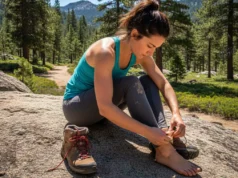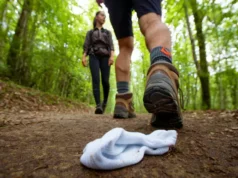In this article
It’s a familiar story: you invested in the best hiking boots and premium wool socks, yet three miles into a hike, a nagging hotspot on your heel signals the start of a blister that could ruin your day. This common frustration isn’t a failure of your main gear, but often the absence of a small, misunderstood component. This guide reveals how the humble hiking liner sock is the secret to fine-tuning your entire footwear system, acting as the critical lightweight baselayer that manages friction and moisture to unlock a new level of blister-free comfort on the trail. A liner sock isn’t a silver bullet; it’s a high-performance tuning component for a properly fitted system of shoes and socks. The right sock liner solves specific problems—friction, moisture, inter-toe rubbing—to elevate your trail comfort from good to exceptional.
Through this guide, you will go from thinking of liner socks as just “thinner socks” to understanding them as specialized gear. You will learn the key performance metrics to understand the science of how a two-sock layering system drastically reduces the friction and moisture that cause blisters. We’ll explore why material matters most, covering the critical differences between Merino wool and synthetics to match the right fiber to your needs. We will help you identify your “hiker persona”—from thru-hikers to day-hikers—and recommend the exact sock liners engineered to solve your specific pain points. And finally, we’ll reiterate that while liners enhance a system, nothing replaces the foundational importance of properly fitted hiking boots or trail runners.
How to Choose the Right Hiking Liner Socks: An Expert’s Framework
Why is Blister Prevention the Top Priority?
Blisters are the enemy of every hiker, capable of turning a beautiful journey into a painful ordeal. They are born from a toxic combination of friction, moisture, and pressure, which creates painful hotspots and eventually, fluid-filled blisters. When your foot gets damp from sweat, the skin softens and its coefficient of friction skyrockets, making it far more susceptible to damage from skin-on-skin friction and rubbing. This is where the form-fitting liner sock performs its most critical function, acting as a “preferential friction surface.” Instead of your thicker socks or main hiking sock grinding against your vulnerable skin, it glides smoothly against the liner.
This system brilliantly transfers the destructive shearing forces away from your foot and into the space between the two sock layers. It’s a simple mechanical solution to a complex biological problem. However, it’s crucial to remember that this entire system is built upon the foundation of properly fitted footwear. A liner sock is a precision tool, not a patch for ill-fitting footwear; a liner sock works within a comprehensive footwear system. While a proper fit minimizes friction, managing moisture is the other half of the blister prevention equation, a fact corroborated by experts at the American Academy of Dermatology Association.
How Do Materials Dictate Moisture Management?
To win the war against moisture, a liner sock must accomplish two key tasks: moisture wicking, which is the action of moving sweat off the skin, and quick drying, which is releasing that moisture into the outer sock and surrounding environment. Different fibers achieve this in fundamentally different ways. Synthetic materials like Polyester, Polypropylene, Nylon, and COOLMAX are hydrophobic, meaning they repel water. They absorb almost no moisture themselves; instead, they use capillary action to physically push liquid sweat through channels in the fabric, resulting in the fastest possible drying speed. Merino Wool, by contrast, is hygroscopic.
It can absorb up to 30% of its weight in moisture vapor directly into the core of the fiber, keeping the surface next to your skin feeling remarkably dry. This process makes it an exceptional tool for temperature regulation (thermoregulation) and provides superior odor resistance, though its overall drying time is slightly slower than top synthetics. This classic wool vs. synthetics debate shows that choosing the right material ensures that high-performance socks prioritize moisture management, a principle well-documented in textile science literature like this study from PMC. Once you’ve chosen the right material, the way the sock is physically constructed is the final piece of the comfort puzzle.
Pro-Tip: For multi-day trips where washing isn’t an option, Merino wool is the undisputed champion. Its natural antimicrobial properties will keep your socks (and tent-mates) happy. For short, intense hikes in hot, humid weather where you expect to sweat profusely, a fast-drying synthetic is often the better choice.
Liner Sock Material Face-Off
Compare key performance metrics for liner sock materials
Odor & Cold Performance
Odor Resistance: ★★★★★
Cold Weather Performance: ★★★★★
Moisture Management
Wicking Speed: ★★★★☆
Drying Speed: ★★★☆☆
Odor & Cold Performance
Odor Resistance: ★★☆☆☆
Cold Weather Performance: ★★★☆☆
Moisture Management
Wicking Speed: ★★★★★
Drying Speed: ★★★★★
Odor & Cold Performance
Odor Resistance: ★★☆☆☆
Cold Weather Performance: ★★★☆☆
Moisture Management
Wicking Speed: ★★★★★
Drying Speed: ★★★★★
What Construction Details Guarantee a Second-Skin Fit?
A proper, form-fitting liner sock is not a luxury; it is a technical requirement for a high-performance fit. A sock that is too loose will inevitably wrinkle and bunch, creating pressure points that lead directly to blisters. A sock that is too tight will constrict blood flow and cause discomfort, especially as feet swell. The first detail to look for is a seamless toe closure. Traditional seams create a ridge of fabric that, inside the tight confines of a boot’s toe box, becomes a major source of irritation. Modern seamless toe construction and flat knit toe seams eliminate this risk entirely. Next, examine the sock’s anatomically designed shaping. A well-defined, reinforced heel pocket, often combined with elastic fibers like Lycra Spandex, allows the sock to perfectly conform to the contours of your foot and retain that shape without slipping.
This meticulous construction, often featuring high-density knitting for durability, is what separates a cheap pair of thinner socks from a true performance liner. Finally, look for features like an elasticized arch brace. This targeted compression support prevents the sock from twisting or sliding during dynamic movements, ensuring it stays exactly where it should. These construction details are just as important as the materials themselves, reinforcing the idea that understanding the construction of your gear is key to performance. Sourcing responsibly, such as adhering to the Responsible Wool Standard, also ensures quality and ethical production. Now that you’re armed with the knowledge to judge any liner sock, let’s look at how we applied this framework to find the best options on the market.
Pro-Tip: When putting on your two-sock system, put the liner on first and smooth out any wrinkles. Then, pull the outer sock on over it carefully, making sure the liner doesn’t bunch up at the toes or slip at the heel. A perfectly smooth application is your first line of defense against friction.
Our Selection Process: How We Built This Guide
To build this guide and earn your trust, we committed to a process of absolute objectivity. We began by setting aside all brand loyalty and marketing claims, focusing instead on creating a data-driven resource that empowers you to find the right tool for your specific needs. Our evaluation framework was built by synthesizing dozens of expert reviews, thousands of user testimonials, and peer-reviewed scientific literature to establish five core scoring criteria: Blister Prevention Efficacy, Moisture Management, Comfort & Fit, Durability, and Temperature Regulation. The selection process itself involved two phases.
First, we conducted a market-wide analysis to identify the top-rated and most discussed liner socks available from brands like Darn Tough, Smartwool, Injinji, and Fox River. Second, we segmented these products by four distinct user personas—from the endurance thru-hiker to the blister-prone novice—ensuring our final, field-tested recommendations are tailored to solve specific, real-world hiking challenges. Please note that the products recommended in this guide were chosen solely based on their performance against our evaluation criteria. If you choose to purchase through our links, we may earn a small commission at no extra cost to you. This helps support our independent testing and research.
The Best Hiking Liner Socks of 2025: Our Top Recommendations for Every Need
Our Top Picks for The Thru-Hiker / Endurance Backpacker
The thru-hiker’s footwear system is their office, their transportation, and their lifeline. Their long-distance journeys on major trails demand uncompromising durability, multi-day odor resistance, and versatile performance across changing climates. For these backpackers, a baselayer sock isn’t just a piece of clothing; it’s a critical tool that has to perform flawlessly for thousands of miles. Here are the top performers that meet these extreme demands.
Our Top Picks for The Day Hiker / Weekend Warrior
The day hiker and weekend warrior needs versatility and reliability. Their adventures might range from a casual forest walk to a strenuous peak ascent, often in the same weekend. They need gear that performs without fuss, providing dependable comfort and moisture management so they can focus on the trail, not their feet.
Our Top Picks for The Ultralight Specialist
The ultralight specialist is obsessed with efficiency, function, and grams. They need gear that serves a clear purpose with no wasted material or weight. For them, a sock system must be streamlined, fast-drying, and mechanically perfect, delivering maximum performance in the lightest possible package.
Our Top Picks for The Blister-Prone Novice
For the hiker just starting out or one who seems to get blisters no matter what, psychological assurance is as important as physical performance. They need a proven, reliable solution that removes doubt and lets them build confidence on the trail. The focus here is on foolproof systems that guarantee protection.
Conclusion
The journey to blister-free hiking begins with understanding that the effectiveness of any liner sock is fundamentally dependent on properly fitted footwear; always address your boot fit first. A liner’s primary job is to manage the twin threats of friction and moisture, acting as a low-friction “second skin” that skillfully transfers shear forces away from your foot. The choice of material presents a clear trade-off: synthetics offer the fastest drying times, while Merino wool provides superior odor resistance and all-weather temperature regulation. Ultimately, the best liner for you is the one that solves your specific problem, whether it’s the all-around durability needed by a thru-hiker or the specialized friction-absorbing design required by someone prone to blisters.
Now that you have the framework to build your perfect footwear system, we want to hear from you. Share your go-to liner and outer sock combination in the comments below!
Frequently Asked Questions about Hiking Liner Socks
Do I really need liner socks for hiking?
No, you don’t always need to wear sock liners, as many modern socks offer excellent performance on their own. However, they are a powerful and often essential tool for preventing blisters and fine-tuning foot comfort. If you regularly experience hotspots, have wet feet, or simply want to improve the performance of your existing sock system, a liner is a fantastic upgrade. A versatile and affordable option like the REI Co-op COOLMAX EcoMade Liner Crew Socks is an excellent and effective place to start.
What is the best material for hiking liner socks?
The best material depends entirely on your primary need. If your main concern is moisture wicking in humid conditions, choose synthetics like polypropylene or COOLMAX for the fastest drying times. If you need superior odor-resistance for multi-day trips and excellent all-weather temperature regulation, choose Merino wool. Thru-hikers often prefer a high-Merino blend like the Smartwool Classic Hike Zero Cushion Liner Sock for its multi-day wearability and comfort.
Can I wear liner socks by themselves?
Yes, in warm and dry conditions, many hikers wear liner socks as standalone lightweight socks, especially with trail runners or light hiking shoes. They are thin, breathable, and comfortable for less demanding outings. However, they offer minimal cushioning (zero cushion) and protection, so for rugged terrain or long days with a heavy pack, it’s always best to pair them with a primary, cushioned hiking sock as they are designed for.
How do liner socks prevent blisters?
Liner socks prevent blisters by creating a smooth, snug-fitting layer that moves with your foot. This layer effectively transfers friction away from your skin to the interface between the liner and your outer sock, so the two fabric layers rub against each other instead of your sock rubbing against your skin. Specialized designs like the Wrightsock Double Layer build this principle into a single product, guaranteeing that friction is absorbed between its integrated inner and outer layers.
Risk Disclaimer: Hiking, trekking, backpacking, and all related outdoor activities involve inherent risks which may result in serious injury, illness, or death. The information provided on The Hiking Tribe is for educational and informational purposes only. While we strive for accuracy, information on trails, gear, techniques, and safety is not a substitute for your own best judgment and thorough preparation. Trail conditions, weather, and other environmental factors change rapidly and may differ from what is described on this site. Always check with official sources like park services for the most current alerts and conditions. Never undertake a hike beyond your abilities and always be prepared for the unexpected. By using this website, you agree that you are solely responsible for your own safety. Any reliance you place on our content is strictly at your own risk, and you assume all liability for your actions and decisions in the outdoors. The Hiking Tribe and its authors will not be held liable for any injury, damage, or loss sustained in connection with the use of the information herein.
Affiliate Disclosure: We are a participant in the Amazon Services LLC Associates Program, an affiliate advertising program designed to provide a means for us to earn advertising fees by advertising and linking to Amazon.com. As an Amazon Associate, we earn from qualifying purchases. We also participate in other affiliate programs and may receive a commission on products purchased through our links, at no extra cost to you. Additional terms are found in the terms of service.





